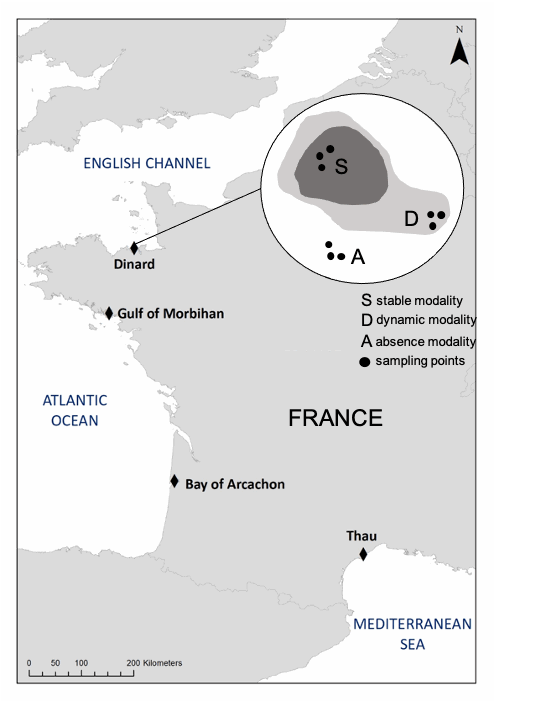MARBEC, Univ Montpellier, CNRS, Ifremer, IRD, Sète, France
Type of resources
Available actions
Topics
Keywords
Contact for the resource
Provided by
Years
Formats
Representation types
-

The data concerns the structure and morphometry of the seagrasses Zostera marina and Zostera noltei, the diversity of the associated epifauna and the benthic fluxes of oxygen, carbon and nutrients. The dataset includes 103 sampling events divided among four sites and spread across three distinct marine biogeographic regions (i.e. the English Channel, Bay of Biscay and Western Mediterranean), and up to five seasons, depending on the site. The sampling scale allows inter-site and intra-habitat comparisons . Environmental conditions are also described at the site scale. As the most comprehensive and broadscale French dataset on seagrass structure and functioning to date, it is useful for both data analysis and management actions.
-

The ICES Working Group on Fisheries Benthic Impact and Trade-offs (WGFBIT) has developed an assessment framework based on the life history trait longevity, to evaluate the benthic impact of fisheries at the regional scale. In order to apply this framework to the Mediterranean sea, several Mediterranean longevity databases were merged together with existing North-East Atlantic ones to develop a common database. Longevity was fuzzy coded into four longevity classes: <1, 1-3, 3-10 and >10 years. Both benthic mega and macrofauna organisms are included in this dataset. Further details about both the purpose and the methodology may be found in ICES (2022) and Cuyvers et al. (2023). The result of the final dataset merging is one dataset containing the fuzzy coded average longevity (and standard deviation) for 2264 taxa and for each, the number of databases used.
-

An observation network was initiated in 2021 in the framework of the CocoriCO2 project to monitore carbonate parameters along the French coastal systems. Six sites were selected along the French Atlantic and Mediterranean coastlines based on their importance in terms of shellfish production and the presence of high- and low-frequency monitoring activities. At each site, autonomous pH sensors were deployed both inside and outside shellfish production areas, next to high-frequency CTD (conductivity-temperature-depth) probes operated through two operating monitoring networks (SNO COAST-HF and Ifremer ECOSCOPA). pH sensors were set to an acquisition rate of 15 min and discrete seawater samples were collected biweekly in order to control the quality of pH data (laboratory spectrophotometric measurements) as well as to measure total alkalinity and dissolved inorganic carbon concentrations for full characterization of the carbonate system. While this network has been up and running for more than two years, the acquired dataset has already revealed important differences in terms of pH variations between monitored sites related to the influence of diverse processes (freshwater inputs, tides, temperature, biological processes).
-

Données de Metabarcoding de phytoplancton marin (18s), taxon bactérien et archés (16s) pour la caractérisation de la diversité marine à partir d'ADN extraits sur filtres (eau de mer ou d'étangs filtrés sur 0,22um ou 3um) selon conditions variables de lumière et de température
-

Since 2004, the Service facility SNAPO-CO2 (Service National d’Analyse des Paramètres Océaniques du CO2) housed by the LOCEAN laboratory (Paris, France) has been in charge for the analysis of Total Alkalinity (AT) and Total dissolved inorganic carbon (CT) of seawater samples on a series of cruises or ships of opportunity conducted in different regions in the frame of French and International projects. Following the first synthesis (Metzl et al, 2024, https://doi.org/10.17882/95414), 24700 new data have been quality controlled and the second version includes more than 67000 observations over 1993-2023. Sampling was performed either from CTD-Rosette casts (Niskin bottles) or collected from the ship’s seawater supply (intake at about 5m depth). After completion of each cruise, discrete samples were returned back at LOCEAN laboratory and stored in a dark room at 4 °C before analysis generally within 2-3 months after sampling (sometimes within a week). AT and CT were analyzed simultaneously by potentiometric titration using a closed cell (Edmond, 1970). Certified Reference Materials (CRMs) provided by Pr. A. Dickson (Scripps Institution of Oceanography, San Diego, USA) were used to calibrate the measurements. The same instrumentation was used for underway measurements during OISO cruises (https://campagnes.flotteoceanographique.fr/series/228/) and MINERVE cruises (https://doi.org/10.18142/128) and new AT-CT data for 2002-2021 in the Indian Ocean and Southern Ocean added in this synthesis. The second dataset is organized in one file with the format: Cruise name, Ship name, day, month, year, hour, minute, second, latitude, longitude, depth, AT (µmol/kg), Flag-AT, CT (µmol/kg), Flag-CT, Temperature (°C), Flag-Temp, Salinity (PSU), Flag-Salinity, nsample/cruise, sampling method, Version number, nsample on file.
 Catalogue PIGMA
Catalogue PIGMA